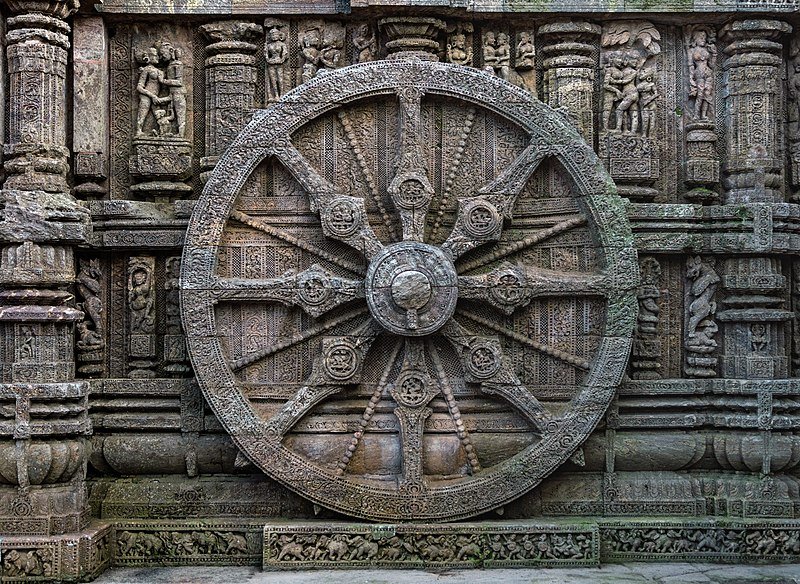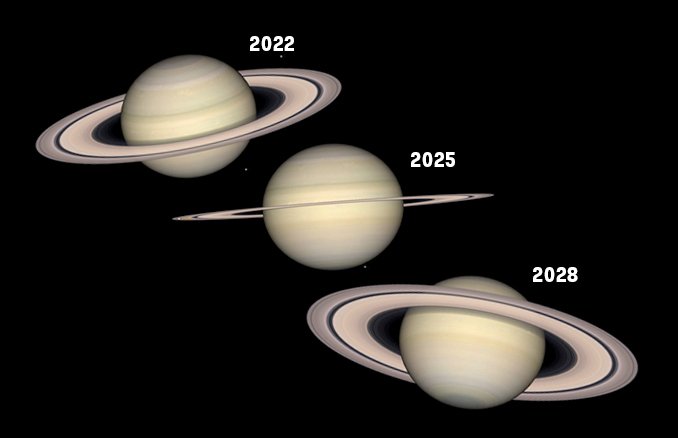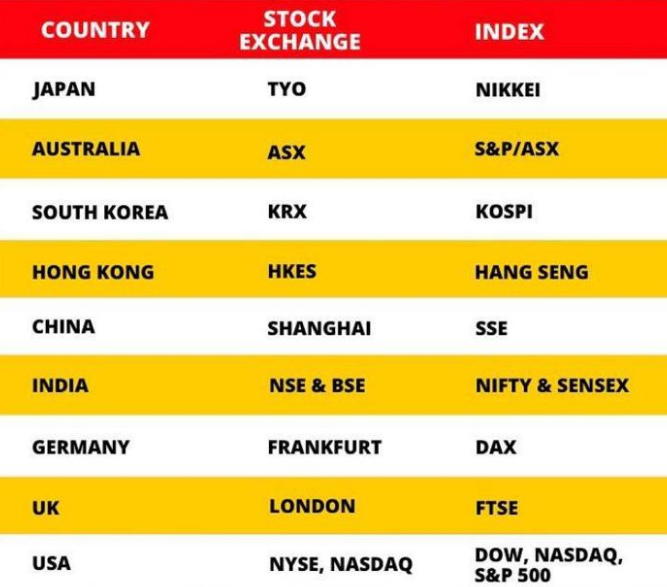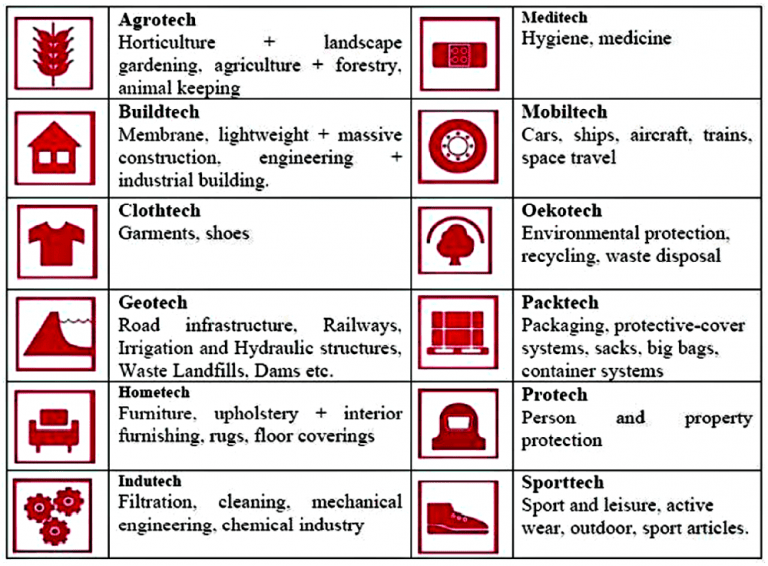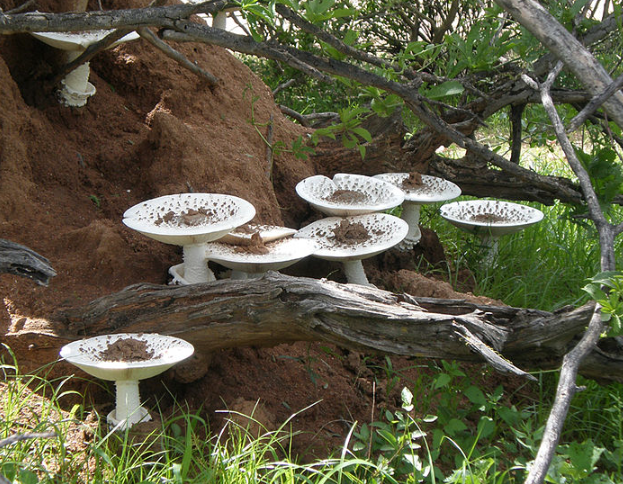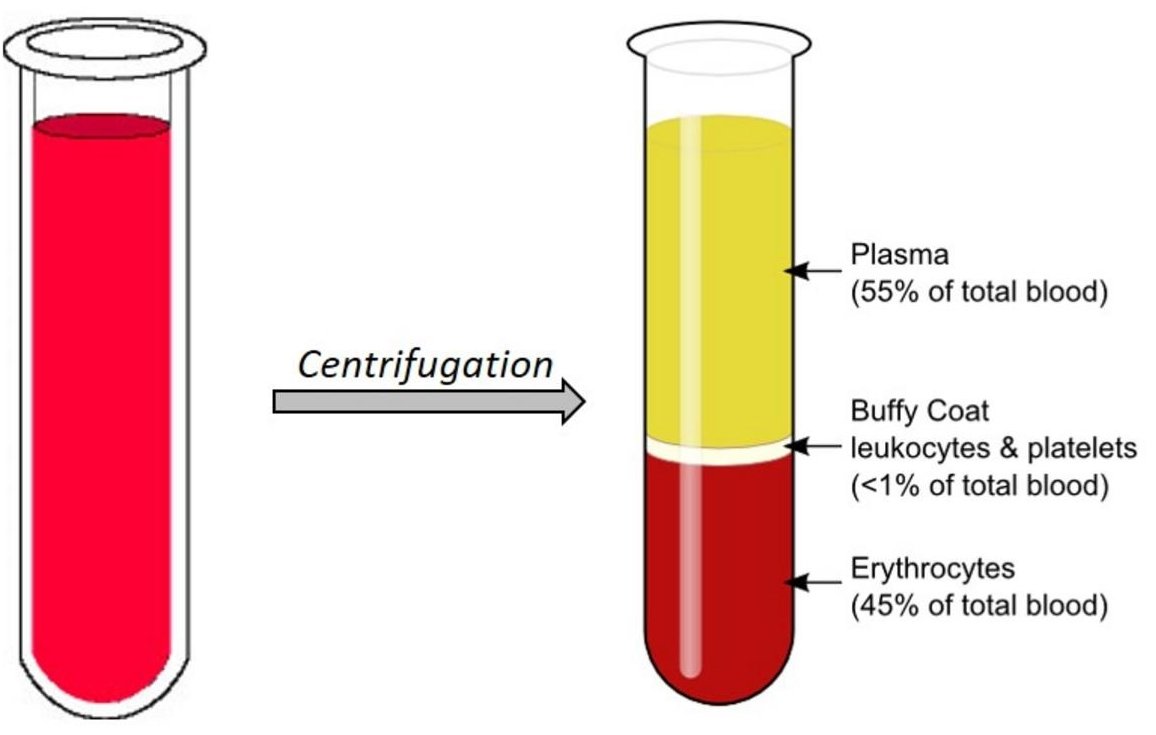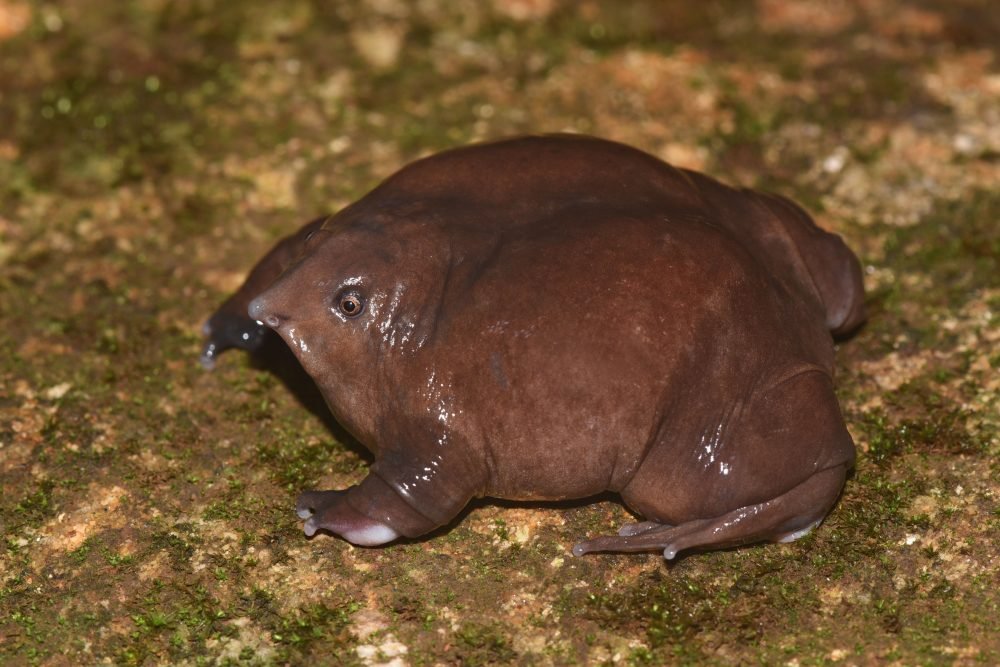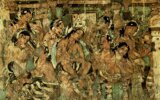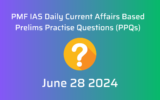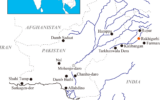
Current Affairs for UPSC Civil Services Exam – June 27, 2024
Subscribers of "Current Affairs" course can Download Daily Current Affairs in PDF/DOC
Subscribe to Never Miss an Important Update! Assured Discounts on New Products!
Must Join PMF IAS Telegram Channel & PMF IAS History Telegram Channel
{GS2 – Polity – IC – Parliament} Election of Speaker
- Context (PIB): Honourable Om Birla was elected as speaker of the 18th Lok Sabha.
Election process of Lok Sabha Speaker
- Article 93 of IC requires the Speaker to be a member of the House. Except that there are no qualifications for the Speaker prescribed in the IC. The date of election of the Speaker is fixed by the President.
- The Speaker is elected from among the Lok Sabha members by a simple majority of members present and voting in the House. He is eligible for re-election.
- A member of the ruling party is elected as the speaker by the Lok Sabha convention.
Term of Office of the Speaker
- The Speaker holds office from the date of his/her election till immediately before the first meeting of the next Lok Sabha.
- Speaker does not vacate his office upon the dissolution of Lok Sabha.
- However, he has to vacate his office earlier in any of the following three cases:
- He cannot preside at the sitting of the House when a resolution for the removal of the Speaker is under consideration of the House.
- He can speak and take part in the proceedings of the House at such a time and vote in the first instance.
Also refer > Presiding Officer of Lok Sabha, Powers of the Speaker
{GS2 – Polity – Laws} The Panchayat (Extension to Scheduled Areas) Act 1996
PESA Act 1996
- Historically, the tribal communities in India have been marginalised and excluded from the mainstream political and economic systems.
- They faced numerous challenges, such as displacement, loss of land and resources, and cultural erosion.
- The PESA Act 1996 was brought in as a response to the long-standing demands of the tribal communities in India for greater autonomy and control over their own affairs.
- It drew inspiration from the provisions of the 73rd and 74th amendments of the Indian constitution.
- It extends the provisions of Part IX of the Indian Constitution relating to the Panchayats to the Scheduled areas with certain modifications.
Significant provisions of the PESA Act 1996
- Gram Sabha: The PESA Act establishes the Gram Sabha, a forum for the community’s participation in the development process.
- The Gram Sabha is responsible for the identification of development projects, the preparation of development plans, and the implementation of these plans.
- Consultation: The Act requires that the Gram Sabha be consulted before any development projects or activities are undertaken in the Scheduled Areas.
- Funds: The Act allows for the transfer of funds to the Gram Sabha and the Gram Panchayat to enable them to perform their functions.
- Land: The Act protects the land rights of tribal communities in the Scheduled Areas and requires their consent before any land is acquired or transferred.
- Cultural and social practices: The Act protects the cultural and social practices of the tribal communities in the Scheduled Areas and prohibits any interference in these practices.
Applicability of PESA Act, 1996
- As of now, applicable in 10 states of Fifth Schedule Areas: Andhra Pradesh, Telangana, Chhattisgarh, Gujarat, Himachal Pradesh, Jharkhand, Madhya Pradesh, Maharashtra, Odisha and Rajasthan.
Role of PESA in forest conservation
- Empowerment of tribal communities: The Act has contributed to the empowerment of tribal communities by giving them a greater say in the development process.
- Control Over Natural Resources: It grants tribal communities control over the management and utilisation of natural resources within their regions, such as land, water, and forests.
- Protection of land rights: The consent of the Gram Sabha must be obtained before any land is acquired or transferred.
- Sustainable Development: Local communities and tribals who have lived in harmony with nature for centuries can manage resources in an environmentally sustainable manner.
- Ensuring Benefits for Tribals: The PESA Act mandates that Gram Sabhas play a crucial role in identifying beneficiaries for various government schemes.
- Preservation of cultural and social practices: The PESA Act has helped to protect the traditions and way of life of tribal communities.
- Promotion of decentralisation: The Act has promoted decentralisation by giving more powers and functions to the Gram Sabha and the Gram Panchayat.
- Improved access to basic services: The PESA Act has contributed to the improvement of access to basic services, such as education, healthcare, and drinking water, in the Scheduled Areas.
Limitations of the PESA Act 1996
- Limited coverage.
- Lack of awareness.
- Limited resources.
- Lack of trained personnel.
- Political interference.
- Conflicts with other laws.
Suggested Measures for Effective Implementation of the PESA Act
- Convergence of laws: Forest Rights Act (2006), the Right to Fair Compensation and Transparency in Land Acquisition, Rehabilitation and Resettlement Act (2013), etc. can be converged with the PESA Act.
- Objective role allocation: The roles of the Ministry of Panchayati Raj and the Ministry of Tribal Affairs should be defined clearly regarding the implementation of the PESA Act.
{GS2 – IR – Africa} India-Kenya Bilateral Relations
- Context (DTE): Kenya and India to forge Bilateral Collaboration in space. The focus will be on expanding Africa’s space capabilities in climate change and food security challenges.
India-Kenya relations
A brief history of India-Kenya relations
- There was an established trade network that connected India and the Swahili Coast (includes modern-day Kenya, Tanzania, and parts of Mozambique) before the arrival of Europeans.
- This network facilitated the exchange of goods and ideas between the two regions, including spreading Islam and Indian culture to the Swahili Coast.
- It was largely maintained by Arab and Persian traders who transported goods such as gold, ivory, and slaves in exchange for textiles, spices, and other luxury items in India.
- During the late 19th and early 20th centuries, both countries were under the British Empire’s control.
- They have a shared history of fighting against the oppressive and exploitative rule of colonial powers.
- In 1948, before Kenya’s independence, India established the office of Commissioner for British East Africa residents in Nairobi.
- After the independence of Kenya in 1963, India elevated the position of the Commissioner to that of a High Commission, officially upgrading diplomatic relations between the two countries.
- India later also set up an Assistant High Commission in Mombasa, the second-largest city in Kenya.
- The India-Kenya Trade Agreement was signed in 1981, under which both countries accorded each other Most Favored Nation status.
- The India-Kenya Joint Trade Committee (JTC) was set up at the Ministerial level in 1983.
Development Cooperation and Capacity Building
- India offers development assistance to Kenya in the form of loans and credit.
- Joint efforts to combat the COVID-19 pandemic and to consolidate economic collaboration during the post-COVID-19 period.
- According to the Kenya Investment Authority (Ken Invest), India is the second largest investor in Kenya.
- Over 400 Kenyan nationals enrol in training and scholarship programmes every year in various fields under the Indian Technical & Economic Cooperation (ITEC) Programme.
{GS3 – S&T – AI} Global Principles for Information Integrity **
- Context (DTE): UN announces a global framework to fight online misinformation and hate speech.
- UN Secretary-General António Guterres says erosion of information integrity compromises the UN’s missions and priorities, including peacekeeping and humanitarian efforts.
Global Principles for Information Integrity (GPII)
- It is a comprehensive framework aimed at addressing the escalating threats posed by misinformation, disinformation, and hate speech in the digital realm.
- It emphasises the necessity of safeguarding human rights and the urgent need for a coordinated international response to make online spaces safer and more humane.
- The seeds for the GPII were sown in the 2021 UN report Our Common Agenda, which envisioned future global cooperation and multilateral action.
Comprehensive recommendations under UN GPII
- Combating disinformation and hate speech: Governments, tech companies, advertisers, and media should avoid supporting or spreading disinformation and hate speech.
- Promoting media freedom: Governments should ensure access to information, maintain free and independent media, and protect journalists, researchers, and civil society.
- Enhancing tech company responsibilities: Tech companies should design products with safety and privacy in mind, apply policies consistently, and focus on protecting vulnerable groups.
- Ethical AI development: AI developers must ensure ethical & safe AI upholding human rights.
- Reforming business models: Tech companies should adopt models that prioritise human rights, privacy, and safety and give users control over their data.
- Transparency in advertising: Advertisers should demand transparency to ensure their budgets don’t fund disinformation or hate.
- Data transparency and accountability: Tech companies and AI developers should be transparent, allow academic access to data, conduct independent audits, and develop accountability frameworks.
- Protecting children: Governments should take special measures to protect and empower children and support parents, guardians, and educators.
Impact of harmful information on global stability
- The unchecked proliferation of false narratives is not only fueling conflict but also undermining democracy, human rights, public health and climate action.
- With the advent of advanced Artificial Intelligence (AI) technologies, these threats are becoming more severe, particularly affecting vulnerable groups such as children.
- A recent UN staff survey revealed that 80% of respondents believe harmful information endangers them and the communities they serve.
{GS3 – Envi – Conservation} Rainforest Conservation
- Context (DTE): Indonesia plans to protect 15 million hectares of its rainforests.
- The country is home to 10-15% of all known plants, mammals, and birds on Earth.
About Rainforest
- Tropical rainforests are mainly located between 23.5°N (Tropic of Cancer) and 23.5°S (Tropic of Capricorn).
- Distribution: Central and South America, central and western Africa, western India, Southeast Asia, New Guinea, and Australia.
- The tropics receive direct sunlight, which creates intense solar energy and keeps temperatures high, usually between 21° to 30°C (70° to 85°F).
- The warm, humid atmosphere in the tropics, with humidity levels between 77% and 88%, results in frequent and intense rainfall, ranging from 200 to 1000 centimetres (80 to 400 inches) annually.
- Tropical rainforests are so warm and humid that they generate up to 75% of their rainfall through processes like evaporation and transpiration.
- Rainforest climate, also known as tropical rainforest climate, is characterised by consistently high temperatures and significant rainfall throughout the year.
Indonesia’s Recent Forest Protection Initiative
- Indonesia unveiled plans to safeguard up to 15 million hectares of rainforest at the Oslo Tropical Forest Forum, hosted by Norway.
- It will lead to a significant increase in the protected forest area, with backing from the Bezos Earth Fund.
- The initiative aims to fulfil Indonesia’s obligations under the 2015 Paris Agreement and the new Global Biodiversity Framework.
India’s Initiatives
- India has several initiatives aimed at protecting its rainforests, including:
- Project Tiger: Focused on tiger conservation. Indirectly protects rainforest habitats in tiger reserves.
- Project Elephant: Aims to protect elephants and their habitats, which include some rainforest areas.
- National Afforestation Programme (NAP): This programme promotes afforestation and reforestation efforts across the country, including in rainforest regions.
- Compensatory Afforestation Fund Management and Planning Authority (CAMPA): Manages funds collected for compensatory afforestation to mitigate the impact of forest land diversion.
- Biodiversity Conservation and Rural Livelihood Improvement Project (BCRLIP): This project focuses on biodiversity conservation, including protecting rainforest biodiversity.
Also refer > Wild Life Protection Act, Forest Conservation Act, Forest Rights Act.
{GS3 – Agri – Crops} Traditional Farming and Indigenous rice varieties
- Context (DTE): Cauvery Delta farmers revert to traditional farming of Indigenous rice varieties amidst rising challenges of growing conventional crops.
Traditional farming
- Centuries-old agricultural methods, usually practised with minimal use of modern technology or inputs. Relies on the use of local seeds and breeds, manual labour, Indigenous knowledge, etc.
- Also focuses on natural resource utilisation and maintaining ecological balance.
Traditional Farming v/s Conventional Farming
|
Traditional farming |
Conventional Farming |
|
|
|
|
|
|
|
|
|
|
|
|
|
|
|
|
Indigenous rice varieties
- Traditional rice varieties that have evolved in a particular geographic region over centuries, adapting to local climate, soil, and farming practices.
- It can be distinguished by its physical characteristics, such as grain shape, colour, and flavour, as well as its ecological adaptability and resistance to pests and diseases.
- Examples of Indigenous rice varieties: Mappillai Samba, Karrupu Kavuni, Thooya Malli, Thanga Samba, Kichadi Samba, Kala Jeevan, Kullakaar, Thooyamalli, Karunkuruvai.
Advantages
- Lesser water and fertilisers are needed, unlike modern varieties, which are very water intensive.
- Ecological adaptation to the climatic and natural challenges of the region.
- Preserve genetic diversity, which is important for the long-term resilience of agriculture.
- Ensures a robust gene pool for future plant breeding.
- Often have higher nutrient levels, including vitamins, minerals, and antioxidants.
Challenges
- Low yield initially compared to other varieties.
- Susceptible to diseases.
- Lack from the government and other organisations.
- Market challenges arise as crops may not be in high demand.
- Vulnerable to climate changes.
- Continued cultivation leads to reduced genetic diversity.
{Prelims – In News} Kenya Mapping
- Context (NDTV): Violent protests are happening in Kenya against government’s proposed tax hikes.
About Kenya

- Location: Eastern Africa along the equator.
- It shares borders with Ethiopia, Somalia, Uganda, Tanzania, and the Indian Ocean.
- Capital: Nairobi, Currency: Shilling, Chief port: Mombasa.
- Languages: Swahili is a national and official language, with English being another official language.
- Kenya’s diverse geographical landscape includes rugged mountain peaks and pristine coastlines, including the Aberdare Range highlands, the Great Rift Valley, white sandy beaches, and coral reefs.
- Lake Turkana (Rudolf) is the world’s largest permanent desert lake. Many anthropologists consider this area the cradle of humankind due to the abundance of hominid fossils.
{Prelims – In News} eSakhsya App
- Context (TH): This mobile-based application helps police record the scene of crime, search for and seizure in a criminal case, and upload the file on the cloud-based platform.
About eSakhsya (e evidence) App
- It is developed by the National Informatics Centre (NIC).
- It is a mobile-based application to help the police to:
- Record the scene of the crime;
- Search and seizure in a criminal case and
- Upload the file to the cloud-based platform.
- The police official will need to upload a selfie after completing the procedure.
- Recorded files are to be uploaded with each First Information Report (FIR).
- The app will be available to all police stations that register and download it.
- The Bharatiya Nagarik Suraksha Sanhita (BNSS) requires audio-video recording of all search and seizure operations in criminal cases.
About New Criminal Laws
To know more about the new criminal laws, refer > The Three Criminal Law Bills. |
{Prelims – In News} International Sugar Organisation *
- Context (PIB): India Hosts the 64th Council Meeting of the International Sugar Organisation.
International Sugar Organization
- An intergovernmental body based in London, it was established under the International Sugar Agreement of 1968 and dedicated to enhancing the global sugar market.
- Membership of around 88 nations including India.
- The ISO is the only worldwide forum for the exchange of views by major producing, consuming and trading countries at an intergovernmental level.
- The ISO administers the International Sugar Agreement (ISA), 1992, which is related to international cooperation in sugar-related matters.
- Encourages expanded sugar use, especially in non-traditional applications.
- However, it lacks the authority to regulate the global sugar trade through price-setting or export quotas.
- Earlier, India hosted the 41st session of the ISO Council Meeting in 2012.
Status of the Sugar Industry in India
- India is the largest consumer and second-largest producer of sugar globally.
- 15% share in global sugar consumption and a robust 20% production rate.
- Nearly 5 crore farmers are engaged in the cultivation of sugarcane.
- Two primary production regions:
- Northern belt encompassing Uttar Pradesh, Bihar, Haryana, Punjab and Bihar.
- Southern belt comprising Maharashtra, Karnataka, Tamil Nadu, and Andhra Pradesh.
- The southern region benefits from a tropical climate, which is conducive to higher sucrose content in crops, resulting in increased yields per unit area compared to northern India.
Government initiatives
- The Government has encouraged sugar mills to divert sugar to ethanol and export surplus sugar so that mills may have better financial conditions to continue their operations.
- The National Policy on Biofuels 2018 provides an indicative target of 20% ethanol blending under the Ethanol Blended Petrol (EBP) Programme by 2025.
- Fair and Remunerative Price (FRP): The government has set the FRP for the 2023-2024 sugar season at Rs. 315 per quintal.
- The Global Biofuel Alliance (GBA) was recently launched by world leaders under India’s G20 presidency to expedite the global uptake of biofuels.
- The workshop on ‘Sugar and Bio-Energy: Emerging Vistas’ being organised during ISO includes various insightful sessions such as:
- Sustainability through Diversification.
- Mechanization & Modernization of the Sugar Sector.
- Digitization of the Sugar Sector.
- Global Demand and Supply of Sugar.
- Green Hydrogen.
Global Biofuel Alliance (GBA)
|







![PMF IAS Environment for UPSC 2022-23 [paperback] PMF IAS [Nov 30, 2021]…](https://pmfias.b-cdn.net/wp-content/uploads/2024/04/pmfiasenvironmentforupsc2022-23paperbackpmfiasnov302021.jpg)
